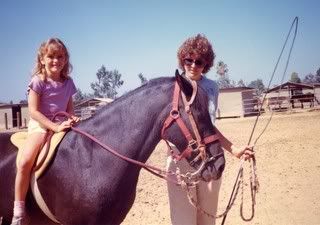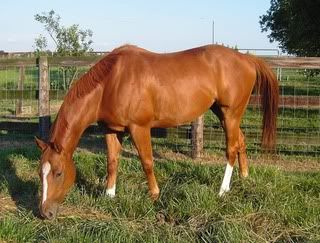My horse is awesome this week, I just have to say. I think perhaps he was abducted by aliens. All of a sudden, he is light in the bridle and staying on the bit. He is stretching out and down into the bit of his own free will during warmup, even at the canter *gasp*! And yesterday...we schooled a course that ranged from 3' to 3'3" -- successfully!!!
I've had a couple of changes of strategy in my rides.
(1) Solo knows where he is supposed to be now, on the bit, so I no longer show him where that is. He has two choices: to either (a) cooperate and be there, or (b) not cooperate and stick his nose up in the air and invert his neck. Should he choose option b, which of course, they always have to periodically try, I simply and quietly close my leg and close my hand at the same time, providing rather irritating resistant contact. I don't say anything, it's not a jerk, just a steady, increased pressure. He is, as intended, quite annoyed by this and decides in a few strides to give and go back down softly to the bit. At which point, I soften (NOT drop the contact) and we return to a light feel. It's working. The basic principle: right thing easy, wrong thing hard and annoying.
 (2) I now incorporate a LOT more canter. I don't know why I wasn't before, it just didn't really happen. I'd ask for it, be annoyed with it's lack of bendiness, cadence, and just not do it for that long. It was part of every ride, but was never very satisfactory.
(2) I now incorporate a LOT more canter. I don't know why I wasn't before, it just didn't really happen. I'd ask for it, be annoyed with it's lack of bendiness, cadence, and just not do it for that long. It was part of every ride, but was never very satisfactory.
Inspired by my BO, whose horse prefers to warm up at the canter, I decided to start every ride with some forward trot with very light contact, letting Solo stretch down of his own accord (which he enjoys), then, on the same super light stretchy contact, ask for canter, get up off his back and let him just canter around on a loopy rein for a little. I don't care if he's perfectly straight, just that he maintains a rhythm.
Revolutionary approach: warm up the canter before you expect anything from it. Duh. But the result is, he is now offering me wayyyy more stretching down at the canter on that light contact, which he didn't used to be strong enough to do. He can reach down, opening his back, and still maintain a quiet rhythm. Go figure -- you can't improve a gait you don't put any thought into working on!
(3) Solo, true to his QH half, is hard to really get moving forward with impulsion at the walk and trot. But, as is true for many horses, right after he canters, we get a really nice swinging trot. I had BO watch us practice the Novice dressage test today and new strategy quickly became obvious. Before beginning a test, we are going to canter almost up to ring entry, then come back to trot and use that nice, forward trot to come down centerline.
Watch out, Novice-levelers, we are coming for you!
I've had a couple of changes of strategy in my rides.
(1) Solo knows where he is supposed to be now, on the bit, so I no longer show him where that is. He has two choices: to either (a) cooperate and be there, or (b) not cooperate and stick his nose up in the air and invert his neck. Should he choose option b, which of course, they always have to periodically try, I simply and quietly close my leg and close my hand at the same time, providing rather irritating resistant contact. I don't say anything, it's not a jerk, just a steady, increased pressure. He is, as intended, quite annoyed by this and decides in a few strides to give and go back down softly to the bit. At which point, I soften (NOT drop the contact) and we return to a light feel. It's working. The basic principle: right thing easy, wrong thing hard and annoying.
 (2) I now incorporate a LOT more canter. I don't know why I wasn't before, it just didn't really happen. I'd ask for it, be annoyed with it's lack of bendiness, cadence, and just not do it for that long. It was part of every ride, but was never very satisfactory.
(2) I now incorporate a LOT more canter. I don't know why I wasn't before, it just didn't really happen. I'd ask for it, be annoyed with it's lack of bendiness, cadence, and just not do it for that long. It was part of every ride, but was never very satisfactory. Inspired by my BO, whose horse prefers to warm up at the canter, I decided to start every ride with some forward trot with very light contact, letting Solo stretch down of his own accord (which he enjoys), then, on the same super light stretchy contact, ask for canter, get up off his back and let him just canter around on a loopy rein for a little. I don't care if he's perfectly straight, just that he maintains a rhythm.
Revolutionary approach: warm up the canter before you expect anything from it. Duh. But the result is, he is now offering me wayyyy more stretching down at the canter on that light contact, which he didn't used to be strong enough to do. He can reach down, opening his back, and still maintain a quiet rhythm. Go figure -- you can't improve a gait you don't put any thought into working on!
(3) Solo, true to his QH half, is hard to really get moving forward with impulsion at the walk and trot. But, as is true for many horses, right after he canters, we get a really nice swinging trot. I had BO watch us practice the Novice dressage test today and new strategy quickly became obvious. Before beginning a test, we are going to canter almost up to ring entry, then come back to trot and use that nice, forward trot to come down centerline.
Watch out, Novice-levelers, we are coming for you!















